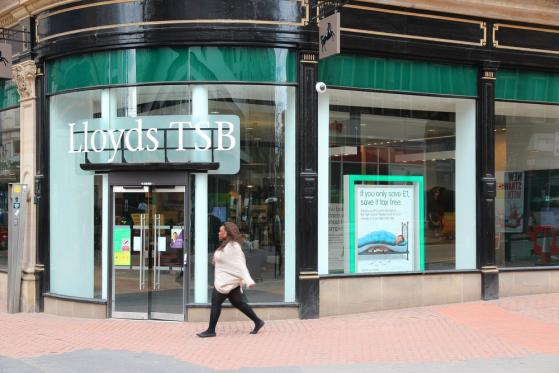Lloyds (LON: LON:LLOY) share price is looking for direction as the company braces for headwinds in key segments. Britain’s biggest bank was trading at 56p on Wednesday, down by over 7.4% from its highest level this year. Despite the retreat, the stock remains 44% above its lowest point this year.
Lloyds Bank is a beloved stock
Lloyds Bank is the biggest player in the UK’s banking sector, where it competes with the likes of Revolut, HSBC (LON:HSBA), Santander (BME:SAN) UK, Barclays (LON:BARC), and Standard Chartered (LON:STAN).
It operates its business through its eponymous brand and other companies like Halifax, Scottish Widows, and Bank of Scotland. Over the years, the company has added over 26 million customers.
Lloyds Bank is significantly different from companies like Barclays, HSBC, and Standard Chartered in that it is primarily a domestic bank with no major investment banking and wealth management divisions.
Together with Natwest (LON:NWG), Lloyds is often seen as a proxy for the British economy. It is also the most popular company in the London Stock Exchange (LSE), where it is held by over 2.2 million individual investors.
These investors love it because of its brand name and its elevated dividend yield of over 5.16%. That yield means that an investor with £100,000 shares in the company will make at least £5,160 in payouts annually.
Lloyds Bank’s investors have been rewarded since the pandemic as the stock jumped from 19.63p in 2020 to over 55p. Still, long-term investors are still in their loss-making zone since the company is yet to recover its Global Financial Crisis (GFC) losses. It peaked at 177.25p at the time.
Lloyds Bank recent earnings
The most recent catalyst for Lloyds Bank share price was its financial results, which had some bright and dark spots.
These results showed that the company’s statutory profit after tax came in at £2.4 billion, down from £2.9 billion in the same period in 2023. Its net income also dropped by 9% as its operating costs rose by 7%.
Most importantly, Lloyds Bank’s net interest income (NII) dropped by 10% to £6.3 billion even as interest rates remained at an elevated level. Therefore, there is a likelihood that this part of its report will continue falling now that the Bank of England (BOE) has started cutting interest rates.
In a statement last week, the BoE decided to slash interest rates by 0.25% because it has achieved its inflation target of 2%. Economists expect the central bank to continue cutting rates to stimulate the economic growth.
In theory, a bank like Lloyds benefits from high interest rates because they lead to high net income margin. However, there is a limit to this trend since high rates impact growth and borrowing trends in the UK. They also lead to high default rates. Therefore, the bank mostly benefits when interest rates are not too high and not too low.
Lloyds Bank expects that its business will continue doing well this year, with its net interest margin being higher than 290 basis points. It also expects that its operating costs will be £0.9.4 billion while its CET1 ratio will be 13.50%.
Lloyds Bank has been reducing its CET1 ratio and it hopes that the figure will drop to 13% by 2026. It is moving some of those savings to reward its shareholders through dividends and share buybacks. It hiked interest rates by 15% and is implementing a £2 billion buyback, which is a substantial amount for a company valued at £2 billion.
The share buyback rewards shareholders by reducing the number of outstanding shares and boosting its earnings-per-share. It is also a sign that the management believes that the stock is cheap as it trades at a price-to-book ratio of 0.76, down from the year-to-date high of 0.83.
Still, the company faces some potential risks, which explains why analysts at Citi downgraded it from overweight to neutral. The analysts noted that the company was exposed to the ongoing Financial Conduct Authority (FCA) review on motor insurance.
Lloyds share price forecast
Conducting a technical analysis can help you determine whether a stock will rise or fall in the short or long term. For short-term investors, it makes sense to use short timeframes like hourly and daily.
In the chart above, we focused on the monthly chart, which can help us predict whether the stock will rise in the longer term. This chart shows that the stock is trading at an important resistance level, where it failed to move above in 2015, 2020, and this year.
This price is also notable because it is the neckline of the inverse head and shoulders chart pattern. In most cases, this is one of the most bullish chart patterns in the market.
Therefore, the Lloyds share price will likely continue rising as buyers target the key resistance at 80p, which coincides with the 38.2% Fibonacci Retracement level. This price is about 43% from the current level.
This article first appeared on Invezz.com
Is LLOY truely undervalued?
With LLOY making headlines, investors are asking: Is it truly valued fairly? InvestingPro's advanced AI algorithms have analyzed LLOY alongside thousands of other stocks to uncover hidden gems with massive upside. And guess what? LLOY wasn't at the top of the list.
Unlock ProPicks AI